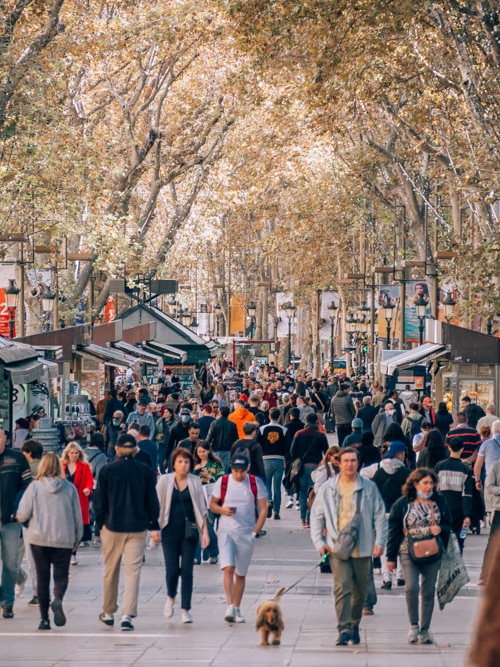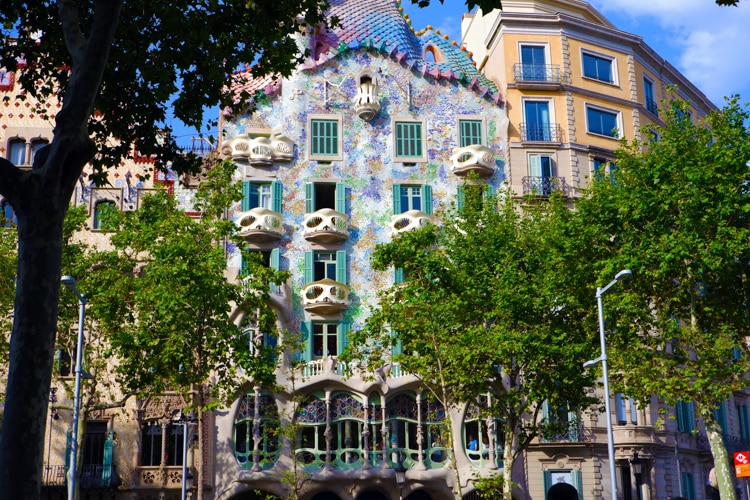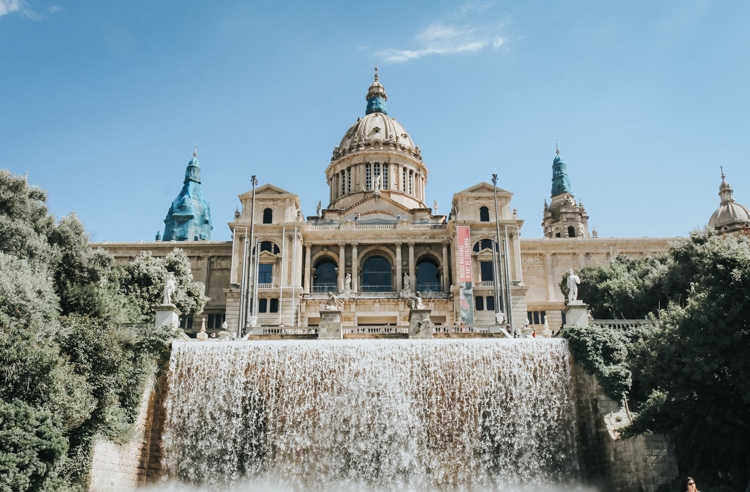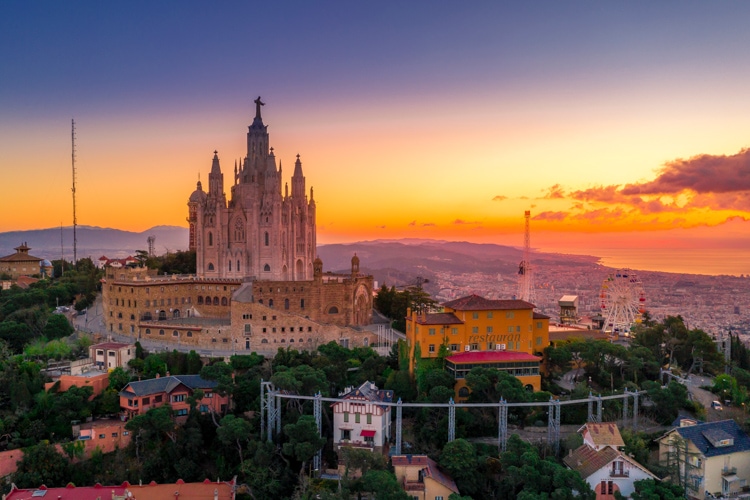
Go World Travel is reader-supported and may earn a commission from purchases made through links in this piece.
Barcelona is one of those cities I always want to return to. The older I get, the more I appreciate its charm and spectacular art. It’s the largest city on the Mediterranean Sea, the best beach city in the world and home to nine spectacular UNESCO World Heritage Sites. A place to delight the eyes, palate and soul—that’s Barcelona.
Due to its unique beauty and essence, Catalonia’s capital is one of Europe’s most visited cities. This second-largest city in Spain was visited by over 12.4 million tourists last year. The Mediterranean climate with long summers (May to September) and mild winters certainly helps, and the beach’s proximity to the city center is an added bonus.
Best Tips & Tools to Plan Your Trip
But Barcelona is much more than that, and you’ll find that when you arrive, you’ll be less interested in the beaches. This is one of the best compliments a city can receive. While simply walking through its streets would be enough, read this travel guide about the top attractions to ensure that beautiful Barcelona shines in all its glory during your visit.
By the way, did you know that the Eiffel Tower was originally supposed to be in Barcelona? So, why isn’t it there? Well, Barcelona rejected it, claiming that it did not fit the city’s style. So, what is the style of Barcelona? Let’s find out.

1. La Sagrada Familia
Some consider it terrifying, others consider it brilliant, but no one can deny that it is one of the most famous top attractions in the world. Almost everybody has heard of Antoni Gaudí’s La Sagrada Familia, which took longer to build than the pyramids. When completed, it will be the world’s tallest Christian church. This is set to happen in 2026, on the 100th anniversary of its architect’s death.
Because of Antoni Gaudí’s inspiration from nature, the basilica is known for its irregular and sinuous lines. It’s full of symbolism, like a magical square on the facade that, no matter how you add it up, always equals 33, Jesus’ age. Of course, Sagrada Familia, along with six other of Gaudí’s projects, is a UNESCO World Heritage Site.

2. Gothic Quarter (Catalan: Barri Gòtic)
A trip back in time awaits you in the Gothic Quarter, in the heart of the old town. It is one of Barcelona’s most charming districts and a great place to lose yourself wandering through the narrow streets. In addition to admiring the remains of the ancient Roman city of Barcino and taking in the historical sights, you can visit some must-see tourist attractions.
First among them is the Barcelona Cathedral—no, I’m not referring to the Sagrada Familia this time. I’m referring to La Seu, a 15th-century cathedral also known as the Cathedral of the Holy Cross and Saint Eulalia. Admire the Cloister of Saint Eulalia and the palm trees on Plaça Reial and Plaça Sant Jaume.
You can also go to the Basilica of Santa Maria del Mar, which is located between the Gothic Quarter and Barceloneta. After that, feel free to return to the present and enjoy some tapas, visit some charming cafes, and take a leisurely stroll through the boutiques. Isn’t this a good time to be alive, after all?

3. The Magic Fountain in Montjuïc
Have you ever seen water dance to the beat of a song?, While strolling down Montjuïc, the Magic Fountain will entertain you with a free show of seven billion different combinations of water, light and music. That’s pretty amazing, isn’t it? You won’t miss it because it’s close to other top attractions like Plaza de Espanya, so make seeing the show your final “to-do” of the day. Performance times vary throughout the year, so check the schedule.
But what’s the backstory? The Magic Fountain was built in 1929 for the International Exhibition. The designer, Carlos Buïgas, was tasked with creating something that would be remembered for a long time. He clearly succeeded because this is still one of the most popular Barcelona attractions.
Keep in mind that many people arrive several hours early to secure a good spot. Oh, and there’s a legend that says if you drink the water from this fountain, you’ll return to Barcelona. If you try it, please share your findings with those of us who were skeptical and did not drink it.

4. La Rambla
La Rambla, Barcelona’s most famous street, is one of the locations that best captures the essence of this city with its unique charm, street entertainment and cultural attractions. This lively boulevard connects Placa de Catalunya (Catalonia Square) to the Christopher Columbus monument, which was built on the exact spot where Columbus landed on his way back from America.
This means you’ll have enough room to appreciate the art of street performers or cheer up the human statues with a few coins. You can also treat yourself to flowers from one of the numerous street stands, purchase a delicious souvenir of local and international cuisine at the Boqueria Market (La Boqueria Market, Mercat) and enjoy a coffee in one of the charming roadside cafes.
Then, when you reach the Christopher Columbus monument, turn around and cross La Rambla at least once more. And if you enjoy the nightlife, return at night to see a flamenco show.

5. Palau de la Música Catalana
What do Muse, Coldplay and Adele have in common? Well, you probably thought the same thing; they all performed at the Palau de la Música Catalana. Or maybe you didn’t. Anyway, stunning on the outside, stunning on the inside—this concert hall with exceptional acoustics is one of Barcelona’s top attractions.
The interior of the Palau is full of details (like ceramic roses, gold color, and massive sculptures) that will give you a sense of sophistication; balcony columns with floral mosaics will give you a touch of playfulness; and Beethoven and Bach sculptures will transport you back in time. You’ll also sigh at the stained-glass windows, whose colors interact with the daylight to create a different atmosphere every day.
So, who was the one to create it? This Catalan modernist masterpiece was built between 1905 and 1908 according to the vision of architect Lluis Domènech i Montaner. Also, here’s a fun fact: Palau is the only concert hall in Europe that is lit only by daylight during the day. In 1997, UNESCO recognized its significance by declaring it a World Heritage Site. Isn’t it well deserved?

6. La Barceloneta Beach and Parc de la Ciutadella
We all adore travel destinations with beaches, don’t we? The most famous beach in Barcelona is in Barceloneta, close to the city center. The golden sand and blue Mediterranean water make it a top tourist attraction, so expect large crowds. Though there isn’t much shade, there are plenty of opportunities for water sports like windsurfing and paddleboarding.
If you prefer to stay on land, you can cycle, jog or rollerblade along the beach promenade. Or you can walk to the Parc de la Ciutadella, the world’s largest park in a metropolitan area, where you can go sightseeing or take a boat ride on the lake.
If you get hungry, go to one of the “chiringuitos,” which are beachside bars and restaurants. You should not rush back to your apartment because days in Spain are long. Instead, enjoy the lively atmosphere and spectacular sunsets on La Barceloneta. Of course, don’t blame yourself if it turns into a night out; it happens all the time on this beach. By the way, did you know that the sand on this beach was imported from Egypt? So, you’ll be able to say you’ve walked through the Egyptian desert.

7. Camp Nou & Olympic
If you come to Barcelona with the intention of crying happy tears at the Nou Camp, I must disappoint you. True football fans are already aware that Europe’s largest stadium is being renovated. So, you can’t currently experience the moments that make football fans’ hearts race, such as sitting on Barcelona’s first-team bench.
You can, however, still visit the FC Barcelona Museum, the city’s most visited museum, with over 1.8 million visitors each year. You can also go to the Olympic Stadium, which is currently home to FC Barcelona’s football heroes. If that isn’t enough, you can wait until the renovation is completed, which is expected by the end of 2025.

8. Picasso Museum
Are you looking for a dose of art in your life? And not just any art, but Pablo Picasso’s artworks. The Picasso Museum is spread across several interconnected buildings in the El Born district. Some of his most important works are presented chronologically, taking you through all stages of his creativity, from adolescence to formative years, and his revolutionary role in the development of Cubism.
By the way, did you know that Frank Gehry drew inspiration from Pablo Picasso’s painting The Accordionist when creating the Guggenheim Museum Bilbao, a facility that has significantly boosted the local economy of Bilbao?

9. Casa Milà (La Pedrera) and Casa Batlló
After being derided for many years, Casa Milà was finally recognized as a UNESCO World Heritage Site in 1984. Today, it is one of the top attractions in Barcelona that visitors simply must see. Casa Milà, located in the Eixample district, is another of Antoni Gaudí’s works that does not accept straight lines.
Its architect was not only focused on aesthetics but also on functionality, so it has one of the world’s first underground garages. Knowing that his original intention was for the building’s occupants to be able to drive straight from the road to their front door makes it even more intriguing.
Antoni Gaudí’s imagination was incredible. The roof of Casa Batlló resembles the dragon’s back from the allegory of St. George, Catalonia’s patron saint, while the balconies display a variety of things, including Venetian masks, skulls and turtles.
Gaudí once again demonstrated his attention to functionality by designing a ventilation system with window openings that aid in the regulation of heat and cold in the building.
If you visit these masterpieces, consider using an audio guide during your walking tour to learn more about architect Antoni Gaudí and his work, as it will provide you with a whole new level of understanding. If you simply cannot get enough of his work, I also suggest visiting Casa Vicens and Palau Güell. I am completely mesmerized.

10. Passeig de Gràcia
Cartier, Tiffany & Co., Louis Vuitton, Gucci, Dior, Chanel… If you are a fashion enthusiast, simply walking past the windows of Barcelona’s most expensive street will be a true fashion adventure. If your wallet says no, you can still have coffee to go in front of Tiffany & Co. to recreate Audrey Hepburn’s famous scene from Breakfast at Tiffany’s.

11. Park Güell
If you want to walk into a fairy tale scene, put Park Güell on your itinerary. It is located on the hills of the city’s Carmel district and was inspired by 19th-century British gardens. A quick glance at the photos reveals whose vision it was, but in case you’re wondering, it’s Antoni Gaudí, and it’s a UNESCO World Heritage Site. So, why Güell and not, let’s say, Gaudí?
Because of Gaudí’s modesty, the park is named after Eusebi Güell, a Spanish businessman who funded Antoni Gaudí’s projects. Although this was intended to be a wealthy neighborhood, the project was not recognized, so a public park was officially opened in 1926. Gaudí lived here until his tragic death, specifically in the exhibition house. This house, which is now a Gaudí Museum, was designed by Catalan architect Berenguer, although it recalls the style of Gaudí’s work.
Don’t miss seeing the 86 Doric columns and taking a selfie with “El draco,” Barcelona’s symbol made in Gaudí’s Trencadis technique. Of course, you should visit the famous snake to take in the breathtaking views of Barcelona. Don’t worry, it’s not a real snake; it’s a stone bench with playful pieces of colorful ceramics, and it’s one of the park’s top attractions.

12. Hospital de la Santa Creu and Sant Pau
Although it may appear strange that I would recommend visiting something with the word “hospital” in its name, don’t worry, it is no longer used as a hospital. It is now the largest European Art Nouveau complex, with impressive architecture and a plethora of colorful tiles, decorations and sculptures. The Hospital de la Santa Creu and Sant Pau was designed by architect Lluis Domènech i Montaner and has been a UNESCO World Heritage Site since 1997.

13. Montserrat
One of the most popular day trips from Barcelona is to Montserrat. You can hike here, take in the scenery, and visit the 10th-century Monestir de Montserrat. Don’t forget to pay attention to La Moreneta (the Black Virgin of Montserrat), the official patron saint of Catalonia since 1881. This statue has been admired by many tourists as well as royal families.
The sounds of children’s singing will add to the warm atmosphere of the holy mountain. The Escolania of Montserrat, one of the world’s oldest all-boys choirs, can be heard in the basilica from Monday to Friday for 10 minutes at 1 PM.
If you don’t have a car or don’t want to drive on the steep and winding roads, you can take a bus or a train (departing from the station at La Plaça España) and a 15-minute thrilling cable car ride to the top. Or you can take one of the guided tours, which will handle everything for you.

14. Palau Nacional & Museu Nacional d’Art de Catalunya
How about a thousand years of Catalan art in a few hours? You can experience this at the Museu Nacional d’Art de Catalunya, which houses art ranging from the 10th to the 20th centuries, including modernism and Art Nouveau. If you enjoy museums, you’ll appreciate the fact that purchasing an Articket entitles you to skip-the-line admission to the top six art museums in Barcelona. Isn’t that fantastic?
Also, while in Montjuïc, I recommend taking a panoramic ride on the Barcelona Cable Car, visiting Poble Espanyol (a beautiful one-of-a-kind museum village with a variety of architecture), admiring Montjuïc Castle, and stopping by the La Fundació Joan Miró (a museum of modern art dedicated to Joan Miró).
Also, football fans, please pay attention: go to the Olympico stadium, which is now home to FC Barcelona due to the reconstruction of Camp Nou. Or even better, watch the match there.

15. Tibidabo
What about a spectacular sunset and wild fun at 512 meters? If you come with children, this is a great place to keep them entertained all day. Tibidabo, the highest peak of the Serra de Collserola, has a beautiful panoramic view and is home to the Temple Expiatori del Sagrat Cor, a Gothic church in an impressive setting.
Best Places to Stay in Barcelona
After you’ve finished the grown-up part of the trip, admiring historical sites, keep in mind that this is also the location of one of the world’s oldest amusement parks, dating back to 1901. When was the last time you had a good time as a kid? If you’re unable to recall, it’s time for Tibidabo. I mean, even the name itself sounds amusing, doesn’t it?
Read More
- The Ultimate Romantic Travel Guide for Couples - November 22, 2024
- A Guide to the 10 Top Things to Do in Trieste, Italy - November 13, 2024
- Plan an Amazing Vacation With These Top 10 Things to Do in Brač, Croatia - November 6, 2024

